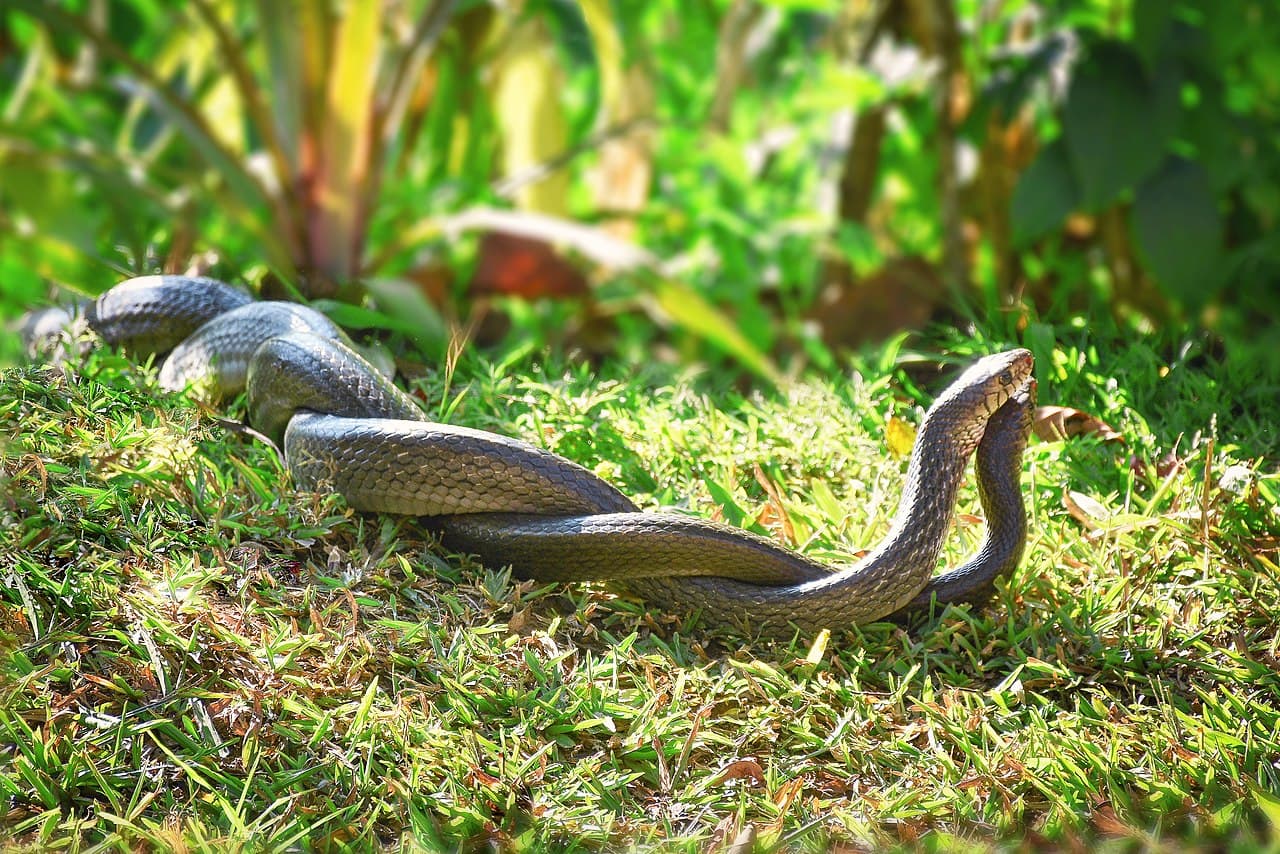Male snakes have two penises, each with its own testicle, but they only use one at a time. During copulation, the male inserts one hemipenis into the cloaca of the female to transfer his sperm. Female snakes can become pregnant immediately or choose to delay fertilization, storing sperm for up to five years.
How Do Snakes Perform Sex?
Male snakes are well-equipped! They possess two independent sets of reproductive systems – including the whole package of hemipenis, testes, ducts, and associated gear. They have an independent set on either side of the body (guess male snakes have two good sides!).
When snakes mate, the male will rub up against the female to elicit a response. Since mating can be intensely competitive between males, the successful male will insert one hemipenis into the cloaca of the female to transfer his sperm.
Interesting factoid: turtles and crocodilians only have a single penis. (Hey, what’s wrong with having just one!?) Another interesting fact: crocodiles might be smarter than you think! See my article How Smart are Crocodiles? Can They Cooperate, Communicate…Use Tools?
You might also be interested in my article about Komodo dragon sex and their forked hemipenis. Dragons take sex seriously and males can kill competitors for the opportunity to mate.
What are Snake Hemipenes and How Do They Work?
Male squamates (snakes and lizards) have a pair of sex organs referred to as the hemipenes (plural). There’s a single hemipenis on each side within the pair. The tricky part about each hemipenis is that it is usually stored inverted in a pocket within the body. (To us male humans this sounds like it could be uncomfortable! Imagine a sock rolled inside-out that must be unrolled every time before use.)
This means that the hemipenis is stored inside-out within the body of the male snake.
When it is time to mate, the hemipenis is deployed for reproduction by being everted via erectile tissue. (As we all know, erectile tissue is what makes the male human reproductive organ such a useful tool.)
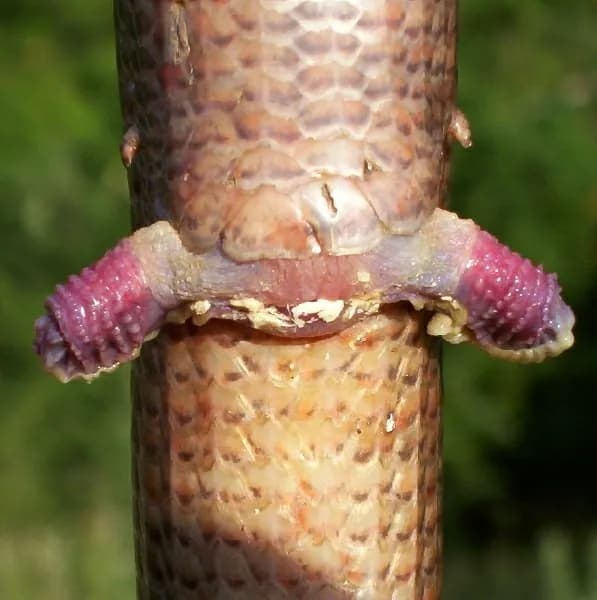
How does the Snake’s Hemipenis Become Everted?
Each hemipenis has a retractor muscle that extends from the tail vertebrae to the tip and sides of the hemipene and the large anal glands positioned above. The hemipene, retractor muscle, and anal gland are all surrounded by the larger propulsor muscle. When the hemipene becomes engorged with blood the propulsor muscle contracts to evert it out like a finger from a glove.
After copulation, the retractor muscle does its work by retracting and inverting the hemipenis back inside the body.
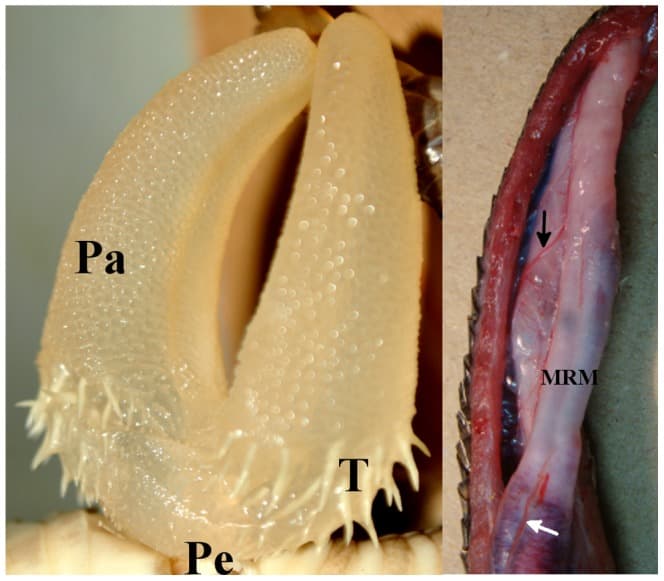
You might be interested in my article on octopus mating – did you know that male octopuses can have an erection?
Why do Some Snakes have Spiny Hemipenes?
Some species of snakes have spiny hemipenes and some don’t. When it comes to sexy snake organs you’ll find a wide assortment if you really want to dig deep.
Scientists have long suspected that these spines play a functional role as a way of anchoring male and female genitalia during copulation. The rationale is that such anchoring could partly replace the function of limbs for hanging on during mating.

After considerable examination of snakes with spiny hemipenes, Cable and Savage (2012) have concluded that spiny hemipenes are not necessarily associated with a reduction of limbs.
We don’t know exactly what role the spines might play, but it is likely that spiny structures might indeed be associated with couple-anchoring, improving the success of mating.
Whatever role they play, they certainly don’t look very comfortable for the female snake. However, mating is all about passing along ones genes, so, evidently, having spiny hemipenes has proven to be a useful evolutionary trait in some snake lineages – comfortable or not.
Why Do Male Snakes have Two Penises?
Male snakes can mate with more than one female if the opportunity arises.
After copulation, a male with only one single penis (like us human mammals) would require a recovery period before he was ready for action with a female.
Having two penises means that a male snake is immediately ready for sex with another receptive female without having to wait during a recovery period. Since female snakes tend to become sexually receptive at roughly the same time, this physiological adaptation on the part of the male snake increases his chances of passing his genes to the next generation.

Do Male Snakes Favor One Penis over the Other?
This might be the answer to the ultimate trivia question, but it seems that snakes often DO favor one hemipenis over the other.
Observant scientists have discovered that some male snakes favor the right hemipenis over the left. In fact, it turns out that the right-hand hemipenis and its associated structures are larger than are the corresponding organs on the left-hand side of the body.
Shine et al (2000) found that male red-sided gartersnakes alternate hemipenis use in successive matings, thereby maximizing the time available for replenishment of fluids.
How do you Determine the Sex of a Snake?
Very carefully! My advice – don’t try this with any snake that you don’t know really, really well.
If you come across a snake in the wild, you will have a very tough time determining its gender. As we’ve seen, the reproductive organs of both male and female snakes are well hidden inside the body until needed for copulation.
Even if you achieved a really good close-up view you wouldn’t stand a chance – sexing a snake is a totally hands-on procedure! A wild snake like this rainbow beauty would NOT tolerate the procedure I’m about to describe below.
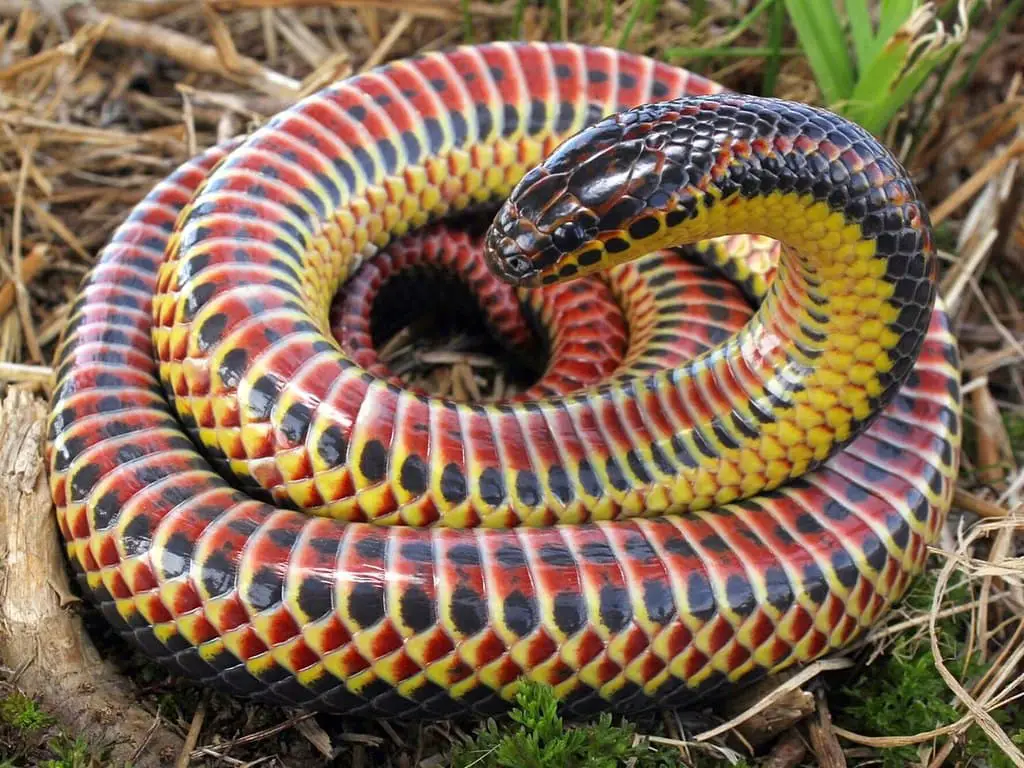
Captive snakes that are used to handling can be sexed using two techniques known as “popping” and “probing.”
Professionals can make these procedures look easy — see the video below. Personally speaking, popping and probing both look like they could irritate even the most docile snake. As a rule, I try to avoid irritating snakes, so I plan to give both of these procedures a miss!
Perhaps sexing a snake is best left in the hands of a professional!
With popping you squeeze the area above the cloaca to see if the hemipenes evert, which would indicate that the snake is a male.
With probing, you use a small probe designed to fit the snake and probe the depth of the reproductive organ. (Hey, easy does it with that probe!!) Since the male’s hemepenes are inverted within the body, they form a deeper pocket than the cloaca of the female.
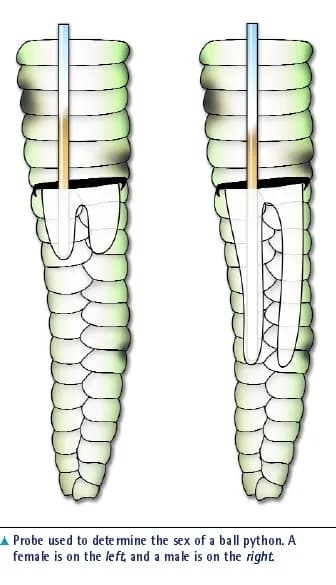
Here’s a video showing how a professional can determine the sex of captive snakes using both popping and probing.
Do Snakes have Sex Orgies? What are Mating Balls?
It is well known that some snake species gather in mating balls consisting of numerous snakes writhing together in a big group. If you see something like this you’ve come across a mating scene, with male snakes doing their best to successfully mate with as many females as possible.
Some snakes, such as garter snakes in North America, hibernate underground for up to eight months in communal dens. Once the weather warms up during spring, the snakes emerge together and form mating balls or, in human terms, what we might refer to as a sex orgy.
Female snakes release sex pheromones that males find irresistible, attracting every male within crawling distance.

During these mating ball sessions, the males compete against dozens, hundreds, or even thousands of other males for a few prized females. The females usually engage for shorter periods than the males, usually a day or two. The males can spend weeks trying to impregnate females under very competitive circumstances.
Video of Mating Ball in Manitoba – Red-sided Garter Snakes by NatureNorth.com
Do Snakes Lay Eggs or Do They Have Live Young?
Some snakes lay eggs (oviparous) and some species have live young (viviparous).
Being oviparous is considered more primitive; but viviparity developed early in the history of snakes, and even some of the most primitive snakes bear their young live.
Snakes that are highly venomous and capable of self-defense are often viviparous. This makes sense, since a capable female, even if pregnant, is much less likely to experience predation. Eggs, on the other hand, tend to be much more vulnerable to predation.
Scientists have observed that bearing young live (viviparity) is often correlated with residence in cold climates. The ability to bear their young live allows these snakes to move into colder areas. It’s no surprise that the records for living at high altitude and in cold latitudes belong to viviparous snakes.
The live-bearing condition is mostly characteristic of snakes that are venomous, or large and powerful; that are restricted to some habitat, especially the aquatic one, where safe nesting sites are few; or that inhabit high altitudes and latitudes, where eggs are menaced by the likelihood of chilling. (Neil 1964).
Do Snakes Build Nests?
Some snakes build nests, such as the King Cobra, to incubate their eggs and some have even evolved egg-brooding behavior (pythons, Farancia, and some Vipers). In these species, the females coil around their eggs until they hatch.
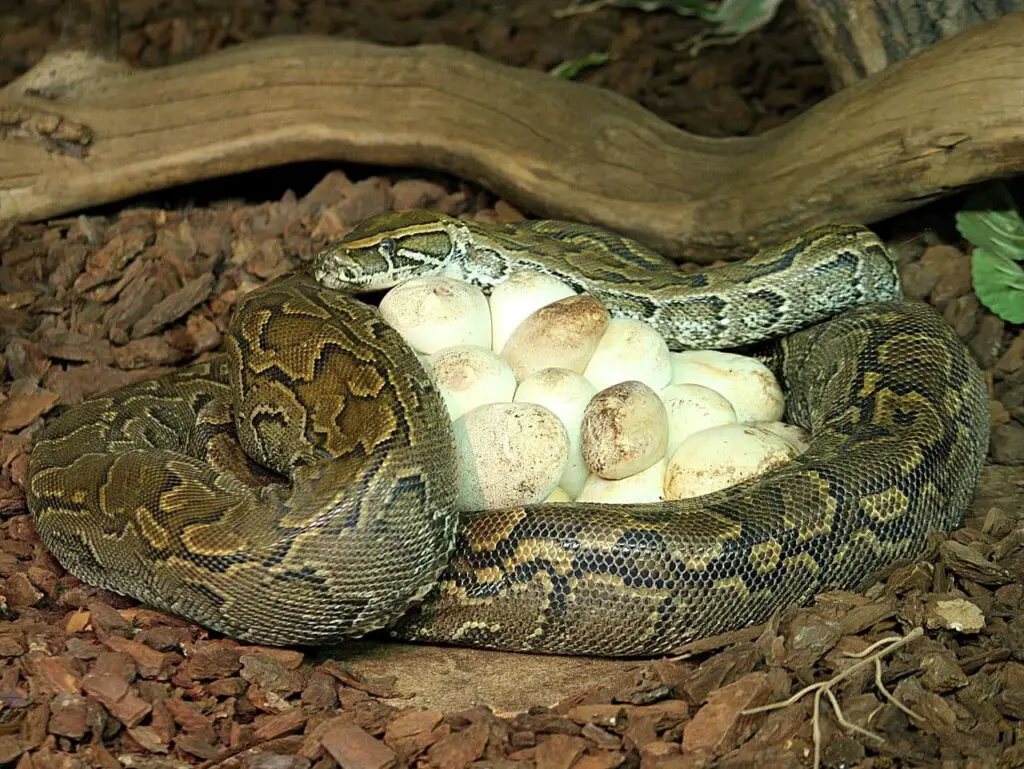
How Did Snakes Evolve – Are They Descended from Lizards?
Based on comparative anatomy we know that snakes originally descended from lizards.
Some of the primitive groups among modern snakes, such as pythons and boas, have vestigial hind limbs known as anal spurs. These are tiny, clawed digits used to grasp the partner during mating.
Can Snakes Reproduce Asexually?
Yes, indeed, some snakes can reproduce without sex! This is called “parthenogenesis” – meaning virgin birth.
Strictly speaking, parthenogenesis, or “virgin birth,” is not considered a form true asexual reproduction since it involves the production of egg cells.
Ok, this is a tricky process that requires a detailed explanation.
Parthenogenesis takes place when a duplicate piece of DNA within an egg does the fertilization, rather than sperm, and it develops to maturity.
The biological process of making an egg cell, called oogenesis, produces four progenitor cells, one of which becomes the egg while the other three typically get reabsorbed by the female’s body. In parthenogenesis, one of the extra cells, having duplicate DNA, acts like a surrogate sperm and fertilizes the egg cell.
This process results in offspring containing the same genetic material as their mother. The snakelets, however, are not miniature clones of the mother. Even with only one parent, there is enough genetic shuffling taking place during the egg production stage to produce unique individual offspring.
Scientists used to think parthenogenesis only happened when there weren’t any males around, sort of an emergency measure that could help save a species. But it turns out that female snakes might choose to produce fatherless offspring even when there are males around.
Imagine being one of those males – spurned because no sex is better than sex with you buddy! Could be hard on the male ego!! (Apologies to the hard-core scientist reading this… sometimes the temptation to anthropomorphise just gets the better of me.)
Biologists have observed that the list of species known to be capable of parthenogenesis— snakes, lizards, birds, sharks, Komodo dragons, and more—has grown significantly in recent years.
Amazing Facts about Snake Reproduction
- The female snake has two sperm receptacles, in some cases these are specialized for delayed or immediate reproduction.
- The male snake keeps his hemipenes inverted inside his body and everts or unfurls them when its time to copulate with a female.
- The female can mate with several males, she can choose which male’s sperm she wants to fertilize her eggs, and she can have snakelets from different fathers in the same litter. Talk about being adept at “sperm juggling!”
- Since females can store the sperm for up to five years, this means they can reproduce long after having sex.
- In fact, some snakes can reproduce without sex! This is called “parthenogenesis” – meaning virgin birth in species that usually reproduce sexually.
- Snake sex can last a whole day, but usually takes about an hour.
- Some primitive snakes, such as pythons and boas, have tiny, vestigial clawed digits used to grasp the partner during mating.
References
Cadle, John & Savage, Jay. (2012). Systematics of the Dendrophidion nuchale complex (Serpentes: Colubridae) with the description of a new species from Central America. Zootaxa. 3513. 1-50. 10.11646/zootaxa.3513.1.1.
Kardong, Kenneth V. Ph.D. (2002). Vertebrates-Comparative Anatomy, Function, Evolution. 3rd Ed. McGraw Hill: New York.
Neil, W. (1964). Viviparity in Snakes: Some Ecological and Zoogeographical Considerations. The American Naturalist, Volume 98, Number 898. Jan. – Feb., 1964. https://doi.org/10.1086/282299
Porto, Marcovan & de Oliveira, Marco Antonio & Pissinatti, Lorenzo & Rodrigues, Renata & Rojas-Moscoso, Julio & Cogo, José & Metze, Konradin & Antunes, Edson & Nahoum, César & Mónica, Fabíola & de Nucci, Germana. (2013). The Evolutionary Implications of Hemipenial Morphology of Rattlesnake Crotalus durissus terrificus (Laurent, 1768) (Serpentes: Viperidae: Crotalinae). PloS one. 8. e66903. 10.1371/journal.pone.0066903.
Sales Nunes, P.M., Curcio, F.F., Roscito, J.G. and Rodrigues, M.T. (2014), Are Hemipenial Spines Related to Limb Reduction? A Spiny Discussion Focused on Gymnophthalmid Lizards (Squamata: Gymnophthalmidae). Anat. Rec., 297: 482-495. https://doi.org/10.1002/ar.22876
Shine, R. M. (2012). Sex at the Snake Den. Advances in the Study of Behavior. https://www.sciencedirect.com/bookseries/advances-in-the-study-of-behavior
Shine, R. M., M. Olsson, M. P. LeMaster, I. T. Moore, R. T. Mason. (2000). Are snakes right-handed? Asymmetry in hemipenis size and usage in gartersnakes (Thamnophis sirtalis), Behavioral Ecology, Volume 11, Issue 4, July 2000, Pages 411–415, https://doi.org/10.1093/beheco/11.4.411
See Our TOP Articles for More Fascinating Creatures
- Are Birds Dinosaurs? Latest Science (How Birds Evolved from Dinosaurs)
- How do Octopus Reproduce? (Cannibalistic Sex, Detachable Penis)
- How Smart are Octopuses? Are Octopuses As Intelligent as Dogs?
- Do Jellyfish have Brains? How Can they Hunt without Brains?
- Why are Deep Sea Fish So Weird and Ugly? Warning: Scary Pictures!
- Are Komodo Dragons Dangerous? Where Can you See Them?
- Koala Brains – Why Being Dumb Can Be Smart (Natural Selection)
- Why do Lions Have Manes? (Do Dark Manes Mean More Sex?)
- How Do Lions Communicate? (Why Do Lions Roar?)
- How Dangerous are Stonefish? Can You Die if You Step on One?
- What Do Animals Do When They Hibernate? How do they Survive?
- Leaf Cutter Ants – Surprising Facts and Adaptations; Pictures and Videos
- Irukandji Jellyfish Facts and Adaptations; Can They Kill You? Are they spreading?
- How to See MORE Wildlife in the Amazon: 10 Practical Tips
- Is it Safe to go on Safari with Africa’s Top Predators and Most Dangerous Animals?
- What to Do if You Encounter a Bullet Ant? World’s Most Painful Stinging Insect!
- How Do Anglerfish Mate? Endless Sex or Die Trying!
- How Smart are Crocodiles? Can They Cooperate, Communicate…Use Tools?
- How Can We Save Our Oceans? With Marine Sanctuaries!
- Why Are Male Birds More Colorful? Ins and Outs of Sexual Selection Made Easy!
- Why is the Cassowary the Most Dangerous Bird in the World? 10 Facts
- How Do African Elephants Create Their Own Habitat?
- What is Killing Our Resident Orcas? Endangered Killer Whales
- Why are Animals of the Galapagos Islands Unique?
- Where Can You See Wild Lemurs in Madagascar? One of the Best Places
- Where Can You see Lyrebirds in the Wild? the Blue Mountains, Australia
- Keeping Mason Bees as Pets
- Why do Flamingos have Bent Beaks and Feed Upside Down?
- Why are Hippos so Aggressive? Why do they Kill People?)

